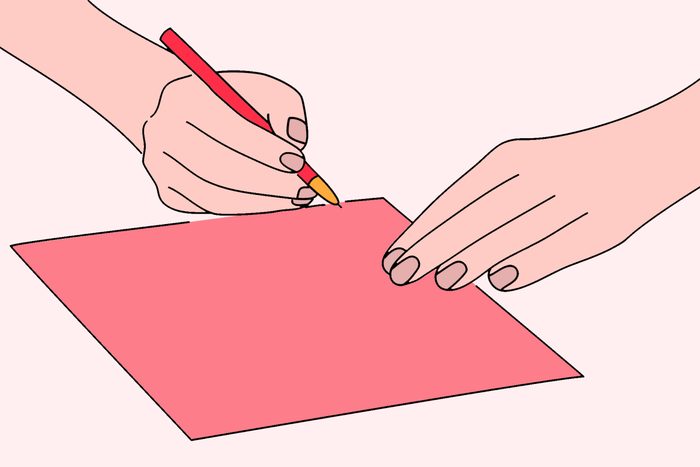
Test yourself
Take a few seconds every day for some simple quizzes. They’ll test your brain, your muscles, and your overall health. Climbing stairs, drawing clocks, and getting in and out of chairs might not seem all that difficult. But these DIY home tests can tell a lot about the state of your body and cognitive functioning. Ready to see how well you’re doing? Take the tests. (Also, check out these daily habits that can help keep your brain healthy.)
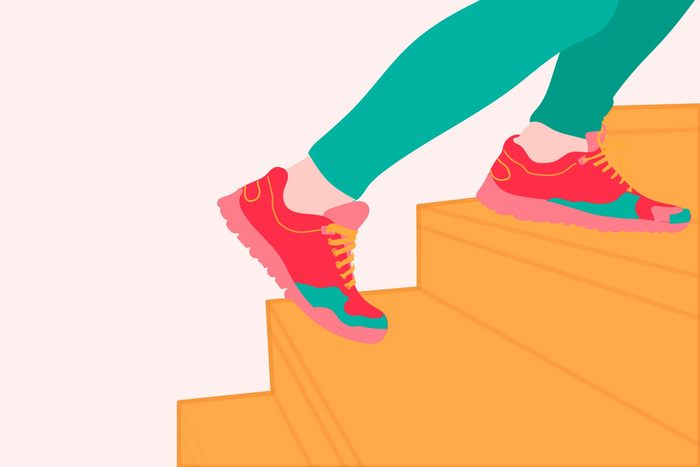
Climb stairs while talking or singing
You’ve probably heard that taking the stairs is a healthy alternative to the elevator. But your fitness level on the stairs can also be used to detect whether cardiovascular problems may be already present. Walk up one flight of stairs while talking or singing a simple song like “Mary Had a Little Lamb.” If you get so winded you can’t talk or sing, or feel a tightening in your chest, see your doctor. (Also, check out the health benefits of singing.)
“I like this test because it helps measure a number of things,” says Jennifer Caudle, DO, family physician, associate professor at Rowan University School of Osteopathic Medicine. “Walking up a flight of stairs while singing or talking not only may tell us how well the heart is functioning, but it also can indicate how well the lungs are functioning.” Getting out of breath easily could also indicate asthma, bronchitis, or chronic obstructive pulmonary disease (COPD).
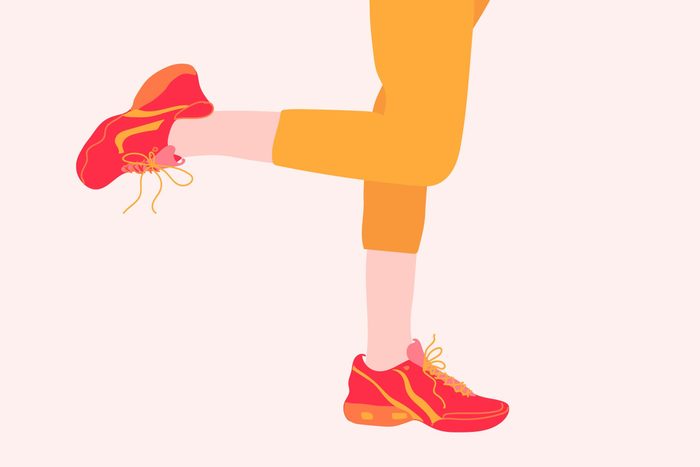
Balance on one leg
These daily exercises may improve your balance, which is one important measure of overall wellness. Time yourself as you stand on one leg with your eyes open. Hold this position for up to 60 seconds. If you wobble after just 20, you could possibly be at risk for future brain problems. In a Japanese study published in the journal Stroke, 30 percent of older adults who couldn’t balance for this long had microbleeds in the brain. These tiny drops of blood in the brain leaked from vessels are only detectable through MRI and are an early indication of risk for stroke or dementia. While these bleeds are a warning sign of bigger brain problems to come, they have an immediate impact on balance as well as a person’s memory and decision-making. (Also, check out these memory strategies you’ll never forget.)

Check your moles
You should know the difference between skin spots in order to find potentially dangerous diseases like skin cancer. “An easy way to decipher if a mole on your body is normal or potentially harmful is to use the ABCDEs,” says dermatologist Purvisha Patel, MD, creator of Visha Skin Care. This handy method stands for asymmetry, border, colour, diameter, and evolving, as outlined by the Canadian Cancer Society. The ABCDE rule will help you determine if you should schedule a screening with a dermatologist.
“When observing a mole on your skin the first thing you want to look at is its shape. Is the mole asymmetrical?” she says. If both halves are the same, it’s probably fine. Next, “An atypical mole will not have a defined border,” she says. If yours looks irregular, get it checked. “Notice if the colour of the mole is all one shade or if it varies. A healthy spot will be one consistent colour,” Dr. Patel says. “The diameter of melanoma [skin cancer] is usually greater than 6 millimetres, or the size of a pencil eraser.” Finally, “Is your mole evolving in size and/or shape?” she says. If so, have it checked by a medical professional.
(Also, here’s how to get rid of those bright red moles.)
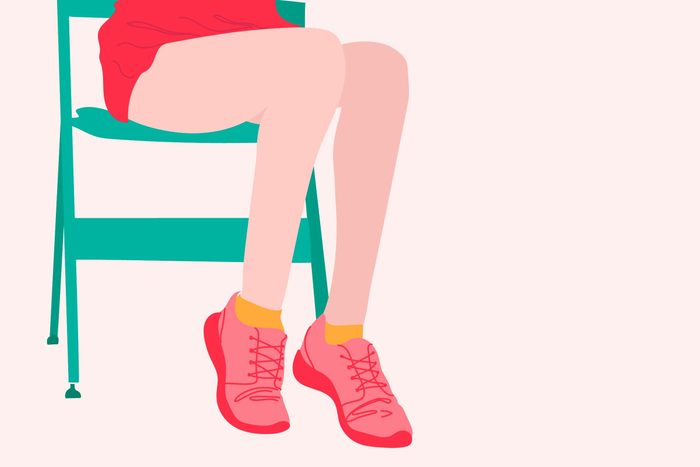
Move from sitting to standing and back again
Sitting could be killing you—and so could be not being able to get up from your seat. Do this chair-to-stand test 10 times, and watch the clock to see how long it takes. Doing well on the test requires lower-body muscle strength and power, balance, and coordination, and cardiorespiratory fitness. Researchers believe that low levels of performance in the test in mid-life could indicate the presence of underlying disease even before symptoms arise. Here are signs you need to move more.
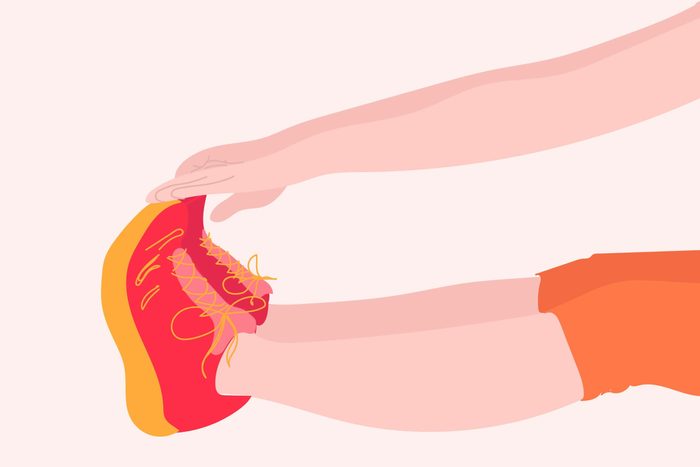
Touch your toes
To test your flexibility, sit on the floor with your back and head pressed up against a wall. Bend forward and try to touch your toes. If they’re still far, far away from your fingers, you may be at risk for cardiovascular problems. Using this test, researchers at the University of North Texas found that a flexible body may be a predictor of flexible arteries.
The reverse was also true: People who were inflexible (and unable to touch their toes) had stiffer, less elastic arteries than those who were more able to bend. When arteries have some give to them, blood can flow easily. When arteries are stiff, due to inactivity or unhealthy habits like smoking, the heart must work harder to pump blood, potentially putting the body at risk for heart attack or stroke. (Here are some ballet moves that’ll improve your flexibility.)
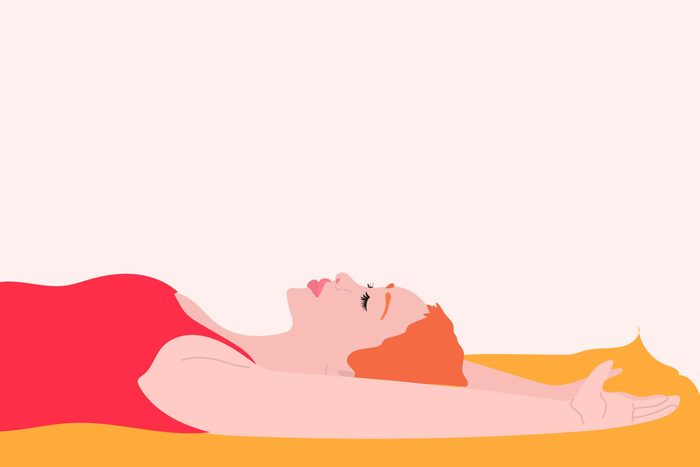
Go from lying down to standing
One of the signs of iron deficiency you might be ignoring is dizziness upon standing. (You may need to eat more foods that are high in iron.) You’ve probably experienced that vertigo-type feeling occasionally when getting out of bed. But if it happens frequently, it could be a sign of anemia, as well as low blood pressure, dehydration, or other conditions. “Changing positions—such as changing from lying down to sitting to standing—involves many systems in the body,” Dr. Caudle says. “The heart, brain, nervous system, inner ear, and many other systems are involved in the process of changing positions.” Experiencing symptoms like dizziness or lightheadedness when rising can be a sign of problems related to these areas of the body. When it comes to low blood pressure, the condition itself isn’t a problem according to the Government of Canada, but if it’s accompanied by dizziness or other symptoms, it’s worth getting checked out.
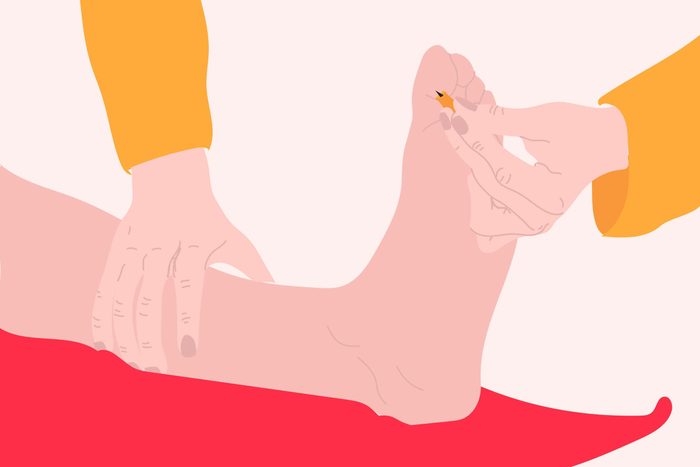
Touch your feet with a pencil
One of the silent diabetes symptoms you may be missing could be numbness in your feet. Such nerve damage can also occur with autoimmune diseases like lupus and infections such as Lyme disease. This numbness could be too subtle to realize on your own, so have a partner test the feeling in your extremities with a pencil. Can you tell without looking if you’re being gently poked with the point or the eraser?
“Touching toes and feet with a sharp but safe object often tells us how well our nerves and sensation is,” Dr. Caudle says. “This is particularly important in patients with diabetes and other conditions which affect the nerves. If you don’t feel sharp objects appropriately at your toes it can be a sign that you have nerve damage—the next thing to figure out is why.” See your doctor to perform further testing. Check out the foods that may help prevent diabetes.

Place a paper on the backs of your hands
One of the early symptoms of Parkinson’s that’s easy to miss might be a slight hand tremor. Although we associate shaky hands with that disease, there are other conditions that could cause this unintentional movement, like overactive thyroid. “Shaking, or tremour, can be caused by many conditions, including neurological conditions [like Parkinson’s], vitamin deficiencies, hormone problems, and more,” Dr. Caudle says. To see if you’re subtly shaking, place a piece of paper over the backs of your hands as you hold them out in front of you. The paper will allow you to see any tremour much more clearly. “This is a surefire way to see if you shake,” Dr. Caudle says.
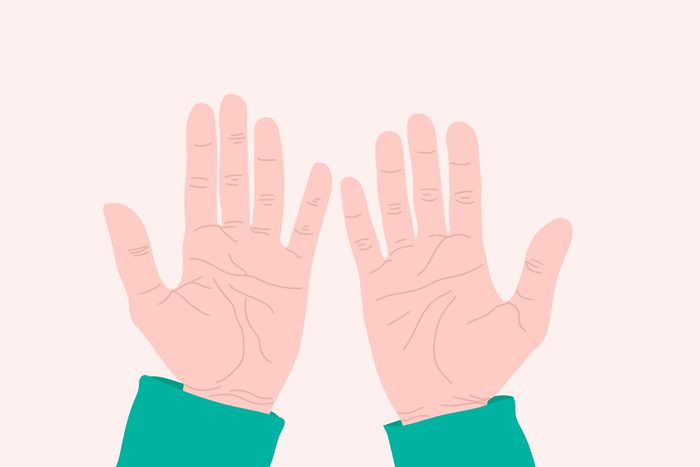
Look at the creases in your palm with fingers stretched
Your hands might predict surprising diseases that could be written on your palm—but this is a different kind of palm reading. “Looking at the creases of the palm can be an important way to help identify severe anemia,” Dr. Caudle says. “With anemia, or low blood counts, it is common for tissues to become pale because the body is lacking blood, or hemoglobin. When the creases of the palm are unusually pale, it could be a sign of low blood counts.” Hold your hand with fingers outstretched and examine if the creases are darker and easy to see. If they’re not, you may be anemic. This test of “palmar creases” is an evidence-based tool doctors themselves use in diagnosing anemia. (Check out the silent signs you’re not taking good care of yourself.)
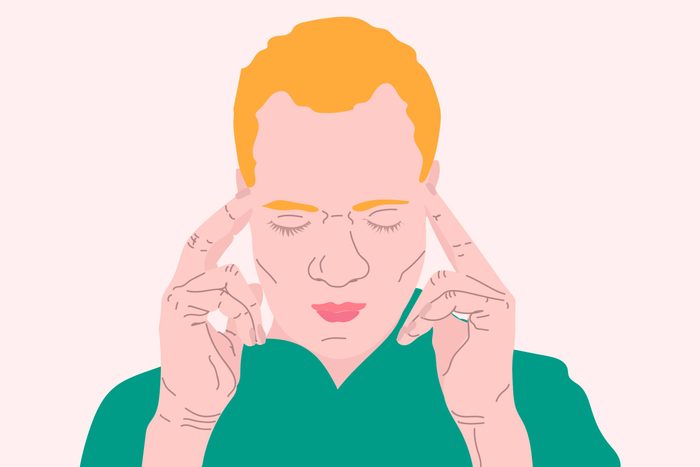
Ask yourself two questions
The hidden signs of depression to watch out for may make themselves clear with two simple questions. Known as the “Whooley questions” for the researcher who developed them, they are: “During the past month, have you often been bothered by feeling down, depressed, or hopeless?” and “During the past month, have you often been bothered by little interest or pleasure in doing things?” If you answer yes to either, further evaluation by a doctor is advised.
Although there are many effective online depression screening tests, a meta-analysis published in BMJ Open showed these two questions are highly sensitive in detecting depression. “Mental health screening tests people take online are enormously helpful—for many, it helps to put a name to their suffering, and for others, it’s a confirmation of what they already know they’re experiencing,” says psychologist Deborah Serani, PsyD, author of Depression in Later Life. “A screening or simple test is not a full diagnosis though, so make sure you follow up with a depression screening by a professional.” She even suggests printing out the test and taking it to your appointment, so you have talking points already highlighted to discuss.

Draw a clock
There are treatable causes of dementia you can recognize before it’s too late, so catching it early can help. One simple DIY test to see if your mind is functioning properly is the clock drawing test. See if you can draw a clock reading 11:10 (or another time can be used as well). Ask a friend to review your clock. If there are errors like missing numbers or the wrong time, it’s cause for calling the doctor.
“This test measures some aspects of visuospatial and executive skills, so people with cognitive impairments involving those parts of the brain may have difficulties with this test,” says Douglas Scharre, MD, director of the Division of Cognitive Neurology at The Ohio State University Wexner Medical Center. “Certain dementias including Alzheimer’s disease will cause people to have trouble performing this test, but it is not diagnostic of any specific cognitive disorder.” (Here’s another sign you might be at risk for dementia.)
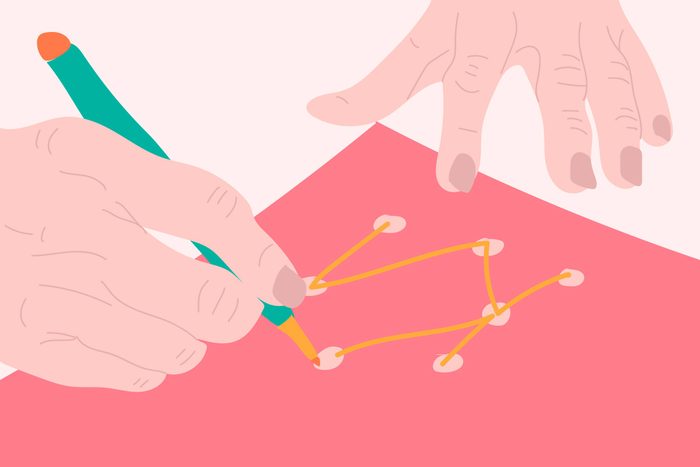
See if you are SAGE
We’re not talking about wisdom, but rather a slightly more extensive dementia test that still only takes less than 15 minutes. The Self-Administered Gerocognitive Exam (SAGE) was developed by researchers at Ohio State’s Wexner Medical Center to detect early signs of mental impairments. “Those who take the SAGE test are tested on orientation—month, date, and year; language—verbal fluency and picture naming; reasoning and computation; visuospatial—three-dimensional construction and clock drawing; executive problem-solving and memory abilities,” says Dr. Scharre. “The SAGE test can help detect memory problems earlier, which is important since treatments for Alzheimer’s and dementia are more effective when started in the earliest stage of the disease.” Although it includes the clock test, Dr. Scharre says SAGE is a “multi-domain, more global assessment of brain function.” Take the test at home, then bring it in to show your doctor if there are any concerning results. (Learn if you can avoid dementia by brushing your teeth.)

Do at-home testing kits
Here’s what happened when one user tried an at-home STD testing kit—and now there are tons more home kits you can take as well. But which ones are most worth it? An easy pee-on strip can help test for painful urinary tract infections easily and quickly without waiting for a doctor’s appointment or urgent care visit. But if it’s positive, you still have to go in to get a script for antibiotics. Some HIV home kits require a finger prick with the blood sent away to a lab, but another tests saliva with a mouth swab, with results ready at home in 20 minutes. Another home test to consider is hepatitis C—especially if you’re a Baby Boomer, because people of that generation are at greater risk for the disease, according to the CDC. It’s actually known as “Boomer’s Disease.”

Complete the sitting to rising test
See if you can do the sitting to rising test (SRT). Stand up straight and then lower yourself into a cross-legged position without using your hands or resting on your knees. Then, also without using your hands or resting on your knees, stand back up again. Developed by researchers in Brazil, the test results reflected mortality in their study. In a follow-up, those participants who could perform the test with less support from hands or knees lived longer.
“The sitting-rising test does not require specific equipment and is safe, easy to apply in a short time period—less than 2 minutes—and reliably scored,” study author Dr. Claudio Gil Araújo of the Clinimex—Exercise Medicine Clinic in Rio de Janeiro said in a press release. “It is well known that aerobic fitness is strongly related to survival, but our study also shows that maintaining high levels of body flexibility, muscle strength, power-to-body weight ratio, and coordination are not only good for performing daily activities but have a favorable influence on life expectancy.”
Next, learn the health conditions that could increase your risk of osteoporosis.
